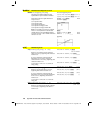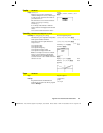
Appendix A: Functions and Instructions 475
8992APPA.DOC TI-89 / TI-92 Plus: Appendix A (US English) Susan Gullord Revised: 02/23/01 1:48 PM Printed: 02/23/01 2:21 PM Page 475 of 132
OneVar
MATH/Statistics menu
OneVar
list1
[[,
list2
]
[,
list3
] [
,
list4
]]
Calculates 1-variable statistics and updates
all the system statistics variables.
All the lists must have equal dimensions
except for
list4
.
list1
represents xlist.
list2
represents frequency.
list3
represents category codes.
list4
represents category include list.
Note:
list1
through
list3
must be a variable
name or c1–c99 (columns in the last data
variable shown in the Data/Matrix Editor).
list4
does not have to be a variable name and
cannot be c1–c99.
{0,2,3,4,3,4,6}
!
L1
¸
OneVar L
1
¸
Done
S
h
owStat
¸
or
MATH/Test menu
B
oolean expression1
or
Boolean expression2
⇒
Boolean expression
Returns true or false or a simplified form of
the original entry.
Returns true if either or both expressions
simplify to true. Returns false only if both
expressions evaluate to false.
Note: See
xor
.
x‚3 or x‚4
¸
x
‚
3
Program segment:
©
If x<0 or x‚5
Goto END
©
If c
h
oice=
1
or c
h
oice=2
Disp "Wrong c
h
oice"
©
integer1
or
integer2
⇒
integer
Compares two real integers bit-by-bit using
an
or
operation. Internally, both integers are
converted to signed, 32-bit binary numbers.
When corresponding bits are compared, the
result is 1 if either bit is 1; the result is 0 only
if both bits are 0. The returned value
represents the bit results, and is displayed
according to the
Base
mode.
You can enter the integers in any number
base. For a binary or hexadecimal entry, you
must use the 0b or 0h prefix, respectively.
Without a prefix, integers are treated as
decimal (base 10).
If you enter a decimal integer that is too large
for a signed, 32-bit binary form, a symmetric
modulo operation is used to bring the value
into the appropriate range.
Note: See
xor
.
In Hex base mode:
0h7AC36 or 0h3D5F
¸
0h7BD7F
In Bin base mode:
0b100101 or 0b100
¸
0b100101
Note: A binary entry can have up to 32
digits (not counting the 0b prefix). A
hexadecimal entry can have up to 8 digits.
Important:
Zero, not the letter O.


















